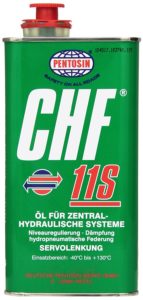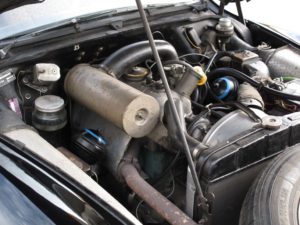(Requires paid member status to access)….
For the past 5 years we have been conducting an experiment in Toronto on a 1960 ID19 running what seems to be an LHS compatible hydraulic fluid. The car has been a test project where we have used synthetic hydraulic fluid in place of LHS. We wanted to use a modern easily obtainable fluid that does not absorb moisture (like LHM), does not destroy the original LHS seals, O-rings and suspension diaphragms and has the viscosity of LHS to retain the legendary “red fluid” like ride of early D models.
First a primer:
Early DS models used a “LHS” suspension fluid which gives a noticeably softer ride than the versions produced from 1967 onward that use “LHM” fluid. The LHS fluid (referred to as red fluid by its colour) was hygroscopic, like most brake fluids, and absorbed moisture causing lines to corrode internally. LHM (green fluid) solved that problem being mineral based, but is not as viscous so the suspension of later model cars do not have the same compliancy. That’s why people say early D models give the ‘true ride of a Citroën’. You cannot mix LHS or LHM fluids or put LHM in LHS cars, or vice versa. Doing so will ruin the all the suspension seals, pump, accumulator etc in the car.
ID models use the same hydropneumatic suspension as the DS. The ID was introduced two years after the DS and was designed to be a little less luxurious and simpler mechanically, therefore easier to maintain. It has a manual 4 speed gearbox instead of the semi-auto of the DS. And it does not have the power steering as in the DS.
LHS was used in D models up to 1967 in Europe and in the USA as late as 1969.
The Solution:
It came about by accident. The ID19 had been worked on for a major leak that occurred when a pipe to the main accumulator had dislodged and the car lost a substantial amount of LHS. At the time of the fix the decision was made to flush the entire system and install fresh fluid. In ordering in what we thought was LHS compatible brake fluid we where shipped Pentosin CHF 11s and it got poured into the ID. It was only after the fluid was in the car that the observation was made, looking at one of the cans, that the fluid was a modern hydraulic fluid. Further referencing to the recommended fluid chart compiled by Tony Jackson and Mark L. Bardenwerper, Sr. at http://citroen.cappyfabrics.com/tony.html indicated that the fluid in the car was actually LHM compatible but not LHS!
Now the question was what to do? The ID19 seemed to be working, but for how long? The Pentozin website states it is: “A synthetic high performance hydraulic fluid for life-time application in modern vehicle aggregates. Pentosin CHF 11S is especially designed for hydraulics in the automotive industry with the highest technical requirements such as in: power steering, level control, shock absorber, hydro-pneumatic suspension, stability and traction control, hydraulics for convertible tops, central lock systems, etc. It is suitable for all extreme conditions and guarantees full performance from -40°C to over 130°C system temperature.”
We wondered if CHF 11S would be compatible as a red fluid like LHS and if putting it into the ID19 in place of LHS would incur any damage to the hydraulic or braking system?
Since the fluid was in the car, what damage was already done? We decided that rather than undergoing the time consuming process of replacing all the LHS seals, O-rings and suspension diaphragms, or installing LHM ones for the CHF 11S, we would leave it as is and wait to see just how long the ID would operate with presumably incorrect LHM compatible fluid. It would now become a rolling test bed for CHF 11S.
We wanted to incur 5 years of testing to ensure there were no issues before reporting our findings, particularly in light of it going against what is stated in published documents about what fluid to use in D models. We are happy to report that it has proven to deliver the best of both worlds; LHM like reliability and a LHS like ride.
Is it a solution?
As part of partial restoration this past fall, (floor panels and interior), we looked inside the ID’s suspension seals, the hydraulic pump, the suspension sphere diaphragms etc to see of there was any deterioration using such fluid. They were all in perfect shape! Quite a breakthrough for what used to be a problem with a LHS type fluid in car like this.
And this use of Pentosin CHF 11s in a LHS “brake fluid” in the ID19 has us wondering if Pentosin CHF 11s could be used as the brake fluid in Traction Avant, and other classic Citroëns (and any other old car for that matter) where conventional DOT 3 or DOT 4 brake fluid resides?
Disclaimer: We are not saying that everyone should be putting Pentosin CHF 11s in their red fluid D models, or changing brake fluid to use it. You do this at your own peril, – and your mileage may vary! However we felt we should report our findings so at least you aware of our experiment and our success so far.
_____________________________
UPDATE: November 17, 2023: After 9 years of Pentosin CHF 11s residing in the “test” 1960 ID19 here in Toronto, by 2022 the hydraulic pump had weakened to the point that it needed to be replaced. We decided to swap it out with a re-manufactured pump that has LHM seals and the car rides and brakes fine once again. Our feeling is that the Pentosin CHF 11s did eventually contribute to the pump failing and as Chris Dubuque points out in the comments below, it should not be used in place of LHS.




FWIW, I had talked about this very fluid for using it with the LHS vehicles, though only for the BVM, not the BVH , but every time that I would have opened it into the DS/ID discussion forums , I was slashed down by the experts in those groups.
Further more , I was referred to the listed as per the Cappy Fabric.
Our company car 1999 Bentley Arnage Green Leaf uses this very Pentosin CHF 11S for its Hydropneumatic suspension.
The Citroënvie post is still only in the members section, I.e not made public, hence some people will always have a different view?
A member of the Ottawa Club has been using Massey Ferguson Mineral Brake Fluid, part #3405389M2, distributed by AGCO corporation, Duluth,GA. http://www.agcoparts.com@AGCO Corporation and has not encountered any problems.
Pentosin also offers LHM+ corresponding to specification PSA Nr G 71 27 10. The text on the label reads: “Pentosin LHM+ meets the new specification for Citroën hydraulic flluid and can be mixed with the former LHM standard grade. LHM+ is only determined for use in the hydraulic brake and suspension system of those Citroën vehicles assembled in or after 1967….”
I hope this is useful information.
Michel Landry.
Hello all,..I have put LHS/brake compatible rubber parts in a jar with this fluid and it was not good,… O rings just went to mush, hoses and other bits look to hold up but it’s only been three days,.. This fluid may be working since the car is an lD and the brake system has dead ends where regular brake fluid is trapped next to the seals,… But running this fluid through a seven piston pump would be a mess in short order,.. Just my opinion,.. Kevin Royer, Akron Ohio USA
I’ll admit it: I ran the 68 red fluid DS with Silicon juice for about two years in the 90s. I tried it to see how it felt, but returned to DOT3 from Wagner to make sure. At the time, I was driving the DS about 2000 miles/3000Km per month. No problem. Detail: When using DOT3 fluid, I add 9% castor oil to prevent high-pressure pump’s failure from lack of lube. I did a west coast trip and at about 2000 miles, the power steering died. Of course, it was at night in a snowstorm, in the Oregon wilderness. I drove on what was left in the suspension for braking and loitered two days at the local motel to rip it apart and temporarily fix it for the remaining 350 miles or so.
Another tidbit: I used an LHM high-pressure pump in that LHS2/DOT3 car. Desperation was the motivation, but having no problems, it stayed until I had rebuilt two LHS pumps, a week later. I then rinsed and ran the defiled LHM pump with kerosene, then refilled it with LHM for storage until installing into the DSpecial. So it seems that Citroen chose LHM-LHS compatible Orings when they changed to LHM.
I have been using Napa’s stores LHM+ fluid with no problems for the past two years. I keep my real LHM fluid stash for the SM. The so-called LHM+ is made by another German company than Pentosin and is dark green. Otherwise, it is good.
Using the LHM in an LHS car would cause the O-rings and seals to swell and wear down to the new size. Returning to LHS2/DOT3 would shrink the rubber and cause oodles of leaks. I tested an LHS diaphragm with LHM and, in some 48 hours, it developed an ugly swelling at the puddle’s spot. It did not recover. So there!
If you were not confused, now you are.
Checking back in on this as it’s been another 5 years. How’s the current thinking?
What is the experiance after this 5 years?
Still the hydrolyc oil you post. Any leaks or still going string?
Still working OK. But the car is an ID19 not a DS, so the hydraulics on the car are only working for suspension and braking. And I think that the seals were changed out from the original LHS type at some point prior to my owing it.
Sounds good. I have a DS19 66 wagon (break). Still have hydrolic steering.
Gonne try it. Its not hydroscopic and that will be nice if it’s not rides a lot.
Also renew al rubbers for LHS ones or LHM?
I would suggest that you change all rubbers to LHM ones. After 10 years – the seals on ID19 master brake cylinder had to be replaced. We can’t be sure if this was due to the Pentosin CHF 11 or just age, but I suspect it was the Pentosin CHF 11.
If we have to replace all the rubbers, we might as well use LHM
I know that my comments are a bit late as this topic was started in 2017, but here it is in late 2023 and I recently was asked to look into what rubber compounds are compatible with Pentosin CHF11S. I dug around on the internet and found a few O-ring and seal manufacturers that listed this oil in their fluid compatibility guides. All of them show CHF11S as “compatible” with Nitrile seals and “not recommended” with Ethylene Propylene seals. This means that CHF11S should NOT be used in a brake fluid / LHS Citroen. Please do not put this fluid in a LHS / Brake fluid car.